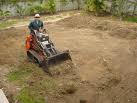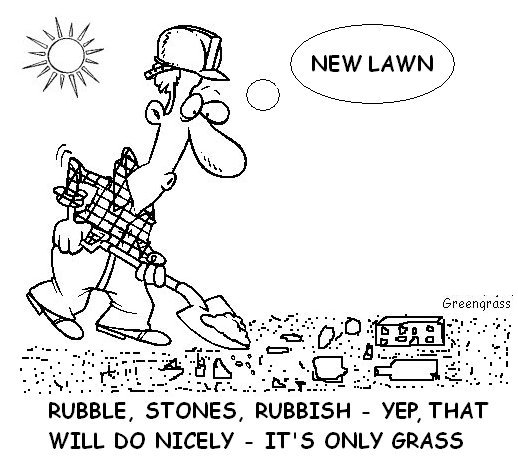Ground/Site Preparation
 |
Ground preparation is often confused with soil preparation. Ground preparation involves removing unwanted non organic materials such as bricks, plasterboard, stones, concrete, polystyrene etc. and may include soil preparation. Unwanted materials provide no growing benefit to the plants (grass) that are intended to be grown in the soil, and may in fact inhibit healthy growth. |

|
Ground preparation is generally required on a new plot of land
after a new dwelling has been constructed, but it may also be needed
when starting a new lawn by
total renovation of an old lawn. This is the first
requirement, and generally involves a machine to perform a lot of
the hard work. Depending on the size, a digger, bull dozer, rotovator
or by hand. Dig a normal
garden fork down to its full depth to test the entire area to be
planted. If it it does not hit any obstacles then all is ok. If not
then remove the unwanted material. Remember warm season grass roots
will try and go down to a depth of over 1 meter. Gardeners walking over a newly planted lawn will soon destroy it.
Plant the trees, shrubs and flower borders first.
Basically laying the lawn should be the last job undertaken. This is the last
ground prep process. Remember, an alternative to
laying topsoil is to correct the existing soil by adding organic
material etc. But if the level is wrong or needs correcting, then a
good topsoil needs to be added. But whether
topsoil is purchased or the existing soil is improved, it is
recommended that fertiliser is added to improve the nutrients in the
soil, ready for the new lawn. Rake, level, tamp down,
remove stones and clumps of clay. Basically the soil needs to be firm but not
compacted. As a guide, if the soil is too loose it will not produce
a properly shaped plug with the plugging tool, and will leave boot
impressions if walked on. Basically when you
plant plugs or sow seed (which means you are going to start watering
the plot) the last thing you want is to see is rogue grass and/or weeds
starting to grow. So water now when it is possible to kill the
unwanted species with "Total Clear" as when the new lawn
is getting established, it's unwise to apply herbicides. And finally a soil pH
test in conjunction with a composition
test is always recommended to ensure a good pH neutral lawn soil
of the right consistancy.
Here are the stages of Ground Preparation recommended for a new
lawn...![]()
Hide this content.



